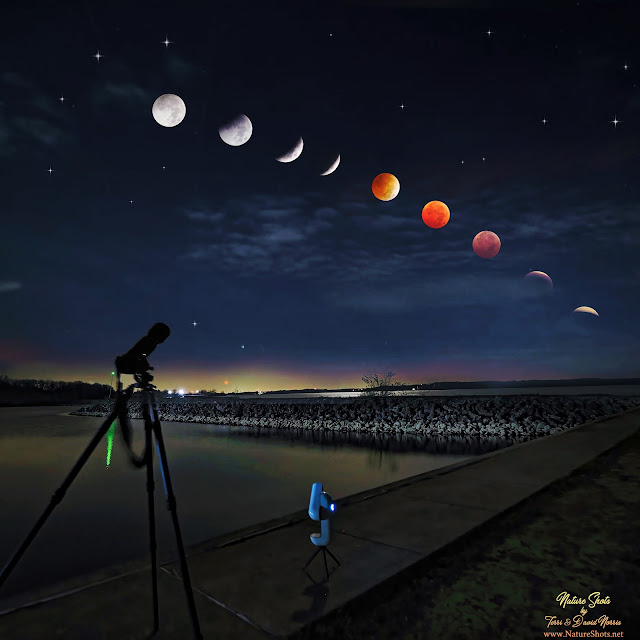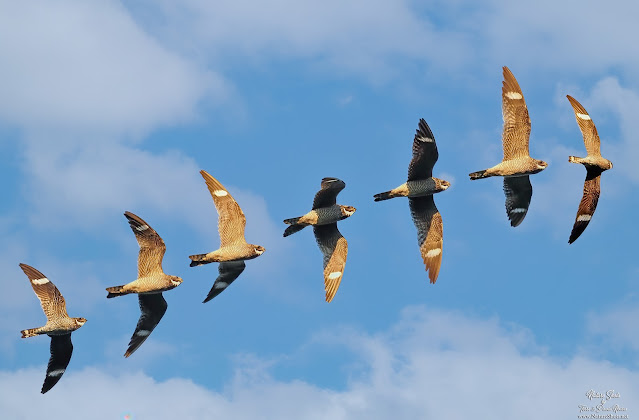We got up at 3am... although neither of us really slept in anticipation of heading to the CJ Brown Marina to watch and photograph the Full Moon Lunar Eclipse.
I had been out to the marina on two recon visits to see which point would be best for shooting foreground images and for the best viewing angle of the eclipse. Using the Photo Pills App, I decided that the Marina would be best.
There's been lots of publicity about this eclipse. Full lunar eclipses happen about every 3 years, but this is actually the second one to occur in 2022 (there was one in May that was not viewable in the US). There won't be another until 2025.
Once we arrived, I set up my OM Systems OM-1 with the 100-400mm on a tripod to get full frame images as the eclipse evolved. I set up David's OM-1 with the Pana/ Leica 8-18mm to get scenic shots of the foreground. And...new this year, I set up the Vaonis Vespera to shoot automatically tracked images.
The Vespera shoots the moon in grayscale, so I didn't plan on using it other that to be able to stay in the warm car and monitor the eclipse progress from my phone screen. It was perfect for that, but it lost the moon as umbra approached, so I retargeted it for a nebula and used to time to shoot images that I'll post later.
While David and Gracie (our pup) dozed, I hopped out of the car every 15 minutes or so to grab shots.
While we didn't have good views of the end of the eclipse (because the moonset was occurring and the moon dropped below the horizon), we did have amazing views of the penumbra, umbral, and the totality stages.
Here's a stacked image of some favorite shots....
Our blog is a journal of our nature photography adventures. All of our images are free to download and use for educational use, presentations and personal printing usage. Please make sure to leave our credits intact!
Image Galleries
- Astrophotography
- Auroras
- Birds
- Buck Creek Corridor and Local Scenes
- Buck Creek State Park
- Butterflies
- Caterpillars
- Cedar Bog
- Dragonflies & Damselflies
- Dragonfly Flight Images
- Ducks & Shorebirds
- Eagles
- Flora & Fungi
- Insects
- Landscapes & Weather
- Magee Marsh Warblers
- Mammals
- Moths
- National Trails Nature
- Owls
- Reptiles & Amphibians
- Spiders
- Sunset Silhouette Series
- Terri Norris Photography (Senior Pics, Weddings, Sports, All People Pics)
- Videos
- Yellowstone National Park
Tuesday, November 8, 2022
Lunar Eclipse.....Yawn
Thursday, September 15, 2022
Monarch Migration
Friday, August 26, 2022
Cormorant at Old Reid
This Double-Crested Cormorant hung out at Old Reid for a few days. While folks up north around the Great Lakes see them as pesky, they intrigue me...and I can't help but love their bright turquoise eyes!
More Shorebirds at CJ Brown
Following another message from the Clark County Birder's group, I headed over to CJ Brown. The text noted that a Willet, a Ruddy Turnstone, and an American Golden Plover were near the beach in drainage ditch.
When I arrived, one of the birders, Dan, told me that a maintenance truck had inadvertently flushed to Willet.
I decided to wait a bit and sat on the concrete to watch some Terns as well as some Pectoral Sandpipers working the shoreline. Sure enough, the Willet returned....first to the shore, then it traveled back to the ditch. It don't know what was so enticing there, but I left after watching the Willet, the Turnstone, and several Killdeer and Mockingbirds have an excellent morning feast!
 |
| Lesser Yellowlegs |
 |
| Ruddy Turnstone |
 |
| Pectoral Sandpiper |
 |
| Caspian Tern |
Wednesday, August 24, 2022
Common Nighthawk Flyover
I was sitting on the deck this evening....enjoying the hummingbirds and their territory war. You'd think that with three large hummingbird feeders there would be enough for all, but not according to the older male....he thinks they all belong to him.
I heard a familiar call and looked up to see two Common Nighthawks cruising over. I snapped a series of shots and about 20 of them were sharp. Here's a stacked image of 7 of them....
I was recently recalling that when I grew up not far from our home, it was commonplace to see large flocks of Nighthawks each evening. I could clearly hear their calls and identify them by the white wing bands.
While I do still see them, they are uncommon, and then only single birds or just a couple. The Nighthawk numbers have declined, and All About Birds cites that the decline of Common Nighthawk populations declined by over 1% per year between 1966 and 2019, for a cumulative decline of about 48%, according to the North American Breeding Bird Survey." A reduction in flying insect populations related to pesticide use is thought to be one of the causes. In addition, Nighthawks nest in gravel patches...including those that used to be common on flat rooftops. The move to avoid the gravel in leu of rubber roofs has led to decreased availability of nesting sites.
Friday, August 19, 2022
Avocets at Sunset
We made a second trip to CJ Brown last evening to catch the American Avocets in the setting sunlight. Also caught some Common Mergansers and a Ring Billed Gull getting a sip of water....
Thursday, August 18, 2022
American Avocets at CJ Brown
From Wikipedia
While we do see them in Clark County, the most I've see is one or two...not 16!






















